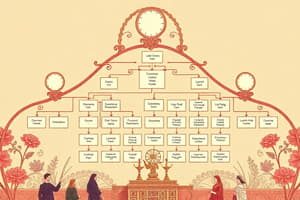Podcast
Questions and Answers
What are the common examples of organizational structures mentioned in the text?
What are the common examples of organizational structures mentioned in the text?
- Flat, round, square, triangular
- Top-down, bottom-up, left-right, circular
- Functional, divisional, matrix, network (correct)
- Traditional, modern, hybrid, experimental
Which organizational structure may lead to siloed thinking among departments?
Which organizational structure may lead to siloed thinking among departments?
- Network
- Matrix
- Divisional
- Functional (correct)
What is a key aspect of effective business communication?
What is a key aspect of effective business communication?
- Encouraging open dialogue and feedback (correct)
- Avoiding any form of written communication
- Keeping information limited to top management
- Micromanaging every task
Which leadership style involves closely monitoring subordinates?
Which leadership style involves closely monitoring subordinates?
In which organizational structure would interdepartmental cooperation be promoted?
In which organizational structure would interdepartmental cooperation be promoted?
What may increase during decision-making processes in a project-based matrix organizational structure?
What may increase during decision-making processes in a project-based matrix organizational structure?
What is an example of an effective communication method mentioned in the text?
What is an example of an effective communication method mentioned in the text?
Which activity is NOT a part of nurturing good decision-making practices as described in the text?
Which activity is NOT a part of nurturing good decision-making practices as described in the text?
What is a key benefit of understanding different leadership styles?
What is a key benefit of understanding different leadership styles?
Which of the following is NOT considered an effective communication method in the text?
Which of the following is NOT considered an effective communication method in the text?
What is a primary focus of strategic planning as discussed in the text?
What is a primary focus of strategic planning as discussed in the text?
Why is creating a consistent flow of information important in business communication?
Why is creating a consistent flow of information important in business communication?
Flashcards are hidden until you start studying
Study Notes
Navigating Business Organization and Management
As you delve into the world of businesses, understanding how companies are structured, led, and make critical decisions is key. Here we'll explore four essential facets of effective business organization and management—organizational structure, leadership styles, business communication, and strategic planning—that collectively drive successful ventures.
Organizational Structure
Organizational structures vary from flat hierarchies with minimal supervision to more complex bureaucratic systems, each influencing productivity, culture, and collaboration within organizations. Common examples of these frameworks include functional, divisional, matrix, and network structures. For instance, a company might adopt a functional approach if it wishes to streamline operations by grouping teams based on similar skills or expertise; however, this may lead to siloed thinking among departments. Conversely, a project-based matrix structure would promote interdepartmental cooperation while potentially increasing complexity during decision-making processes.
Leadership Styles
Leaders come in diverse forms, from authoritarian figures who closely monitor subordinates to democratic leaders whom team members help guide through consensus building. Great managers effectively utilize their preferred leadership styles to encourage engagement, innovation, and high performance amongst employees. Understanding the advantages and shortcomings inherent to different styles can enable leaders to adapt accordingly when faced with unique challenges.
Business Communication
Effective communication is integral in ensuring optimal coordination between various stakeholders, including investors, suppliers, customers, and employees. Creating a clear and consistent flow of information among parties keeps everyone informed and aligned towards common goals. Effective communications include methods such as formal memos, emails, meetings, presentations, newsletters, intranet posts, and employee training programs. Additionally, active listening promotes mutual respect and facilitates creative problem-solving.
Strategic Planning and Decision Making
Strategic planning is an ongoing process involving analyzing internal capabilities and external environments to determine appropriate courses of action and resource allocation. This exercise enables organizations to assess opportunities and threats, shape market positions, evaluate potential risks, and establish attainable objectives. Nurturing good decision-making practices requires considering multiple perspectives, exploring alternative solutions, gathering robust data, testing scenarios, taking calculated risks, and evaluating outcomes objectively.
In summary, successes in the realm of business organization and management necessitate a modular understanding of concepts surrounding organizational structures, leadership styles, communication strategies, and strategic planning. By examining these facets, aspiring entrepreneurs and executives will find themselves better equipped to navigate the dynamic landscape of modern commerce.
Studying That Suits You
Use AI to generate personalized quizzes and flashcards to suit your learning preferences.




